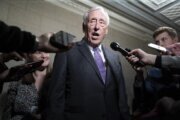The Federal Open Market Committee, led by its new chairman Jerome Powell, decided to raise the federal funds target range by 25 basis points, to a range of 1.5 percent to 1.75 percent, continuing the slow and steady pace of interest rate hikes initiated by his predecessor, Janet Yellen.
It was exactly what the market expected — but there were a few key comments Powell made in his first public speech as chairman that investors should keep in mind.
[Read: How the Fed Is Affecting Income Investors.]
Here are the key data points that came from Wednesday’s FOMC policy meeting, and a few telling comments that might have gone under the radar.
FOMC meeting: the basics. The Fed’s decision to raise rates by 25 basis points reflects a strengthening economy, reflected in extremely low unemployment rates and a growing gross domestic product that’s being stimulated by tax cuts and a budget deal that will raise federal spending by $300 billion over the next two years.
Importantly, the FOMC signaled that there would be just three rate hikes in 2018, the same number expected during the last Fed meeting in December. Some observers thought the Fed might hike four times this year, but inflation hasn’t gotten high enough to justify that.
That said, the Fed announced it is increasing its 2019 projection from two rate hikes to three, and is increasing its 2020 projection from one rate hike to two.
Short-term Treasury bonds rose on the news, as the market showed relief there likely wouldn’t be four rate hikes in 2018. Though longer term five- and 10-year Treasuries initially fell, they were also up slightly in late afternoon trading.
Three of Powell’s subtle signals. Financial stocks rose as the prospect for higher rates in 2019 and 2020 buoyed the shares.
Here are some interesting points Powell made during his first press conference as chair:
— “Trade policy has become a concern going forward” for some international trading partners, Powell mentioned, saying in so many words that some members on the committee recognized President Donald Trump’s aggressive protective tariffs could negatively impact the economy. If there is a tit-for-tat trade war, even the new Fed chair is willing to say that it probably won’t be great for markets.
— “In some areas asset prices are elevated,” Powell says. He specifically mentioned “equity prices and commercial real estate prices,” but added, “we don’t see it in housing, which is key.”
— With that said, Powell bullishly concluded that, “I don’t think that recession probabilities are particularly high right now.”
All in all, Wednesday’s Fed meeting shows that not much has changed policy-wise. Powell was succinct and straightforward in his answers, which the market appreciates.
[See: 7 of the Best Dividend Stocks to Buy for 2018.]
Stocks could be slightly overvalued, and if a trade war emerges there will be definite downside risk, but until then, the economy remains on track to keep growing amid growing employment and tailwinds from the tax cuts and budget deal.
More from U.S. News
7 of the Best Stocks to Buy for 2018
10 of the Best Cheap Stocks to Buy Under $10
7 of the Best Bank Stocks to Buy for 2018
3 Things for Investors to Know About the Fed Interest Rate Hike originally appeared on usnews.com







